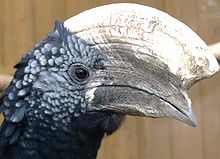- Silvery-cheeked Hornbill
-
Silvery-cheeked Hornbill 
Male (facing away) and female (looking at the photographer) at Lagos Zoo, Portugal Conservation status Scientific classification Kingdom: Animalia Phylum: Chordata Class: Aves Order: Coraciiformes Family: Bucerotidae Genus: Bycanistes Species: B. brevis Binomial name Bycanistes brevis
(Friedmann, 1929)Synonyms Ceratogymna brevis
The Silvery-cheeked Hornbill (Bycanistes brevis) is a large bird at 75 to 80 centimetres (30 to 31 in) in length with a very large creamy casque on the beak. The female has a smaller casque and reddish skin around the eyes. The head is silver-grey and the rest of the plumage is iridescent black, except for the white rump, lower back, thighs, vent and tip of the outer tail-feathers. Silvery-cheeked Hornbills are residents of the tall evergreen forests of East Africa from Ethiopia to South Africa. In Zimbabwe it is threatened by habitat destruction and its presence in South Africa is marginal, but it remains locally fairly common, especially in the northern and central parts of its range. Usually they live in pairs and sometimes roost in flocks of hundreds of individuals. This hornbill feeds on fruits, insects, small birds, rodents, small reptiles and centipedes. They breed in spring (September and October; at least in part of its range) and lay clutches of 1 to 3 white eggs, incubated for 40 days. The young remain with both parents for circa 80 days.
References
Categories:- IUCN Red List least concern species
- Bycanistes
- Birds of Kenya
- Animals described in 1929
- Coraciiformes stubs
Wikimedia Foundation. 2010.


